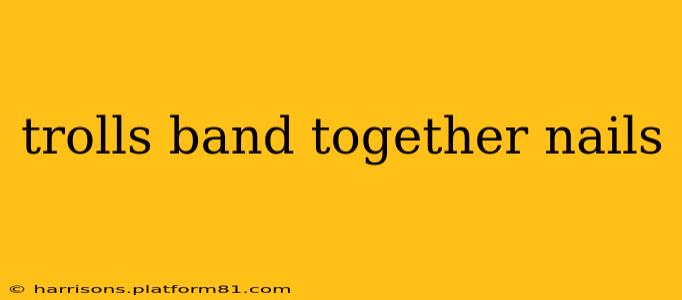When Trolls Band Together: Understanding Online Harassment and Mob Mentality
The internet, a seemingly boundless space of connection and information, also harbors darker corners where coordinated harassment thrives. The phenomenon of "trolls banding together" represents a concerning aspect of online interaction, fueled by a complex interplay of individual motivations and group dynamics. Understanding this behavior is crucial to mitigating its harmful effects and fostering a more positive online environment.
This article will explore the psychology behind online trolling groups, examining the factors that contribute to their formation and the devastating consequences of their actions. We'll also delve into strategies for identifying and addressing this type of coordinated online harassment.
Why do trolls band together?
This question touches upon the core of the problem. While individual trolls might act out of various motivations—ranging from boredom and attention-seeking to genuine malice—the collective action amplifies the harm significantly. Several factors contribute to this banding together:
-
Anonymity and Lack of Accountability: The internet provides a veil of anonymity that emboldens individuals to engage in behavior they would never consider in face-to-face interactions. Knowing their identity is hidden, trolls feel less accountable for their actions. This is further amplified within a group, as individual responsibility diffuses.
-
Group Polarization and Echo Chambers: Online groups often create echo chambers where like-minded individuals reinforce each other's negative biases and beliefs. This can lead to group polarization, where the group's opinions become more extreme over time. The shared animosity towards a target intensifies within this environment.
-
Social Contagion and Mimicry: Witnessing others engage in negative behavior can encourage similar actions in others. This social contagion effect is particularly potent online, where the actions of a few can quickly spread and escalate within a group. The behaviour becomes normalised within the group dynamic.
-
Power Dynamics and Hierarchy: Many online troll groups exhibit hierarchical structures, with certain individuals wielding more influence than others. This power dynamic can encourage further abusive behaviour, as members strive for approval and status within the group.
-
Shared Identity and Purpose: Trolling groups often form around shared interests, grievances, or ideologies, providing a sense of belonging and purpose for their members. This shared identity strengthens group cohesion and reinforces their collective actions.
How do coordinated troll attacks affect victims?
The effects of coordinated trolling attacks are often severe and long-lasting. Victims can experience:
-
Significant psychological distress: Feeling targeted by a large group can cause intense anxiety, depression, and feelings of isolation and helplessness.
-
Damage to reputation and career: Online harassment can damage an individual's reputation, impacting their professional and personal lives.
-
Real-world consequences: In some cases, online harassment can escalate to offline threats and violence.
-
Increased feelings of self-doubt and vulnerability: Constant negativity and abuse can erode a victim's self-esteem and confidence.
What can be done to address coordinated online harassment?
Combating coordinated trolling requires a multi-pronged approach:
-
Platform responsibility: Social media platforms need to implement stronger measures to identify and address coordinated harassment campaigns, including improved reporting mechanisms and proactive content moderation.
-
Community building: Fostering positive online communities where individuals feel supported and empowered to report harassment is crucial.
-
Education and awareness: Raising awareness about the dangers of online harassment and promoting empathy and respectful communication is essential.
-
Legal action: In severe cases, legal action can be taken against perpetrators of coordinated online harassment.
What are the legal ramifications for trolls banding together?
The legal consequences vary depending on the jurisdiction and the severity of the harassment. However, coordinated attacks can lead to charges of cyberbullying, stalking, defamation, and hate speech, depending on the content and impact of the actions. The severity of punishment increases when evidence of coordinated planning or organization can be shown.
How can I protect myself from coordinated troll attacks?
Protecting yourself from coordinated troll attacks requires vigilance and a proactive approach. This includes:
- Limiting exposure: Being mindful of your online presence and limiting personal information shared online.
- Blocking and reporting: Blocking abusive users and reporting harassment to the relevant platforms.
- Seeking support: Reaching out to friends, family, or support groups for emotional support.
- Documenting the harassment: Keeping records of abusive messages and behaviours for possible legal action.
The issue of trolls banding together is a complex and evolving one, demanding collaborative efforts from individuals, platforms, and legal systems to effectively address its harmful impact. By understanding the psychology behind this behavior and implementing proactive strategies, we can work towards creating a safer and more inclusive online environment.
